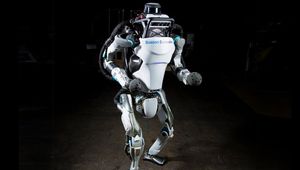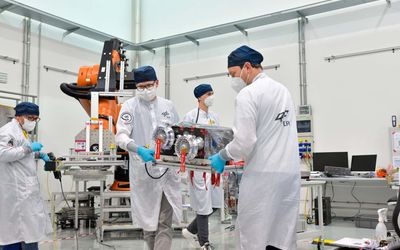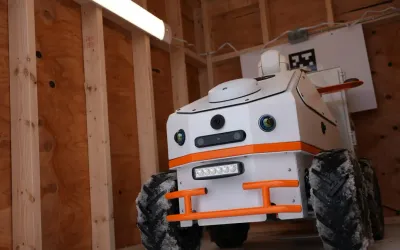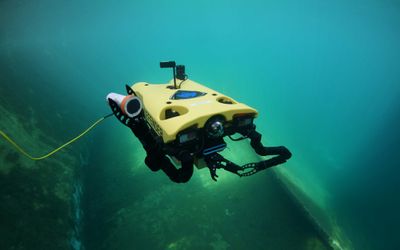X-RHex
A hexapedal robot with a single actuator per leg, intended for real-world mobile applications. X-RHex is an updated version of the RHex platform, designed to offer substantial improvements in power, run-time, payload size, durability, and terrain negotiation, with a smaller physical volume and a comparable footprint and weight. Furthermore, X-RHex is designed to be easier to build and maintain by using a variety of commercial off-the-shelf (COTS) components for a majority of its internals.
Overview
X-RHex is an updated version of the RHex platform, designed to offer substantial improvements in power, run-time, payload size, durability, and terrain negotiation, with a smaller physical volume and a comparable footprint and weight. Furthermore, X-RHex is designed to be easier to build and maintain by using a variety of commercial off-the-shelf (COTS) components for a majority of its internals.
X-RHex carries a fully programmable GPU for fast, parallel sensor processing.
Design
Despite the images of agile humanoid or animal-like robots long held in the public imagination, legged robots capable of dynamic locomotion have only recently been developed. One of the first such dynamical machines is RHex, a hexapod with a single, unrestricted rotary actuator per leg. While mechanically simple, this design has achieved a variety of interesting locomotion tasks, including walking, running, pronking, leaping and flipping, climbing stairs, and even running upright on its rear legs.
**Figure 1: **The X-RHex robot with handles attached.
The main objectives for the mechanical design of X-RHex were to improve frame durability (both in resistance to fatigue and impact) and overall robot serviceability while achieving similar or better performance to past robots.
The overall dimensions (57x39x7.5 cm) were intended to maintain as much similarity to Research RHex (54x39x13.9 cm) as possible. The most notable difference is that the X-RHex frame is much shorter at a total height of 7.5cm. Lateral inter-leg distances are identical, but longitudinal inter-leg distances are 2cm greater.
Research RHex leg design was preserved, and since the leg mounts are nearly centered on an overall thinner body, the robot can operate with greater ground clearance even when in an inverted state. This is a useful feature in the eventuality of robot inversion in a constrained space.
Body Design
The X-RHex frame is light and stiff to optimize locomotive performance, and sufficiently strong to protect hardware and maintain structural integrity even when subjected to severe impacts. The body features a bottom frame and a top plate, as seen in Figure 2a. The bottom frame is constructed from several aluminum 7075-T6 structural pieces including two runners and three cross pieces. The top plate is made from a single sheet of 1/8” aluminum.
The alloy Al-7075 was selected for its high yield strength and machinability. Though a monolithic base was considered, a multi-component base frame is more serviceable (i.e. for repairing damaged sections) and adaptable to future design iterations. The motor mount assemblies are anchored at the ends of each cross piece and function as structural elements connecting the bottom and top frames (see Figure 2). This configuration increases the overall structural stiffness of the frame by increasing the second moment of inertia with a minimal increase in frame mass.
Figure 2: Mechanical construction of the robot.
Two non-structural cross pieces in the bottom frame act as heat sinks for the motor controllers (see Figure 2b). This arrangement was chosen for two reasons: 1) to consolidate three motor controllers into a single, easily removable, electronics module, and 2) to provide a larger thermal mass for the motor controllers to sink heat into.
Carbon fiber panels, as seen in Figure 2a, were added to increase frame stiffness and to protect the robot from outside obstacles while not significantly increasing body weight. Specifically, carbon fiber U-channels line the sides and serve the dual purpose of reinforcing the frame and enclosing internal components. A carbon fiber shell slides on from the side of the robot to provide additional protection to the front, back, and bottom of the robot.
**Figure 3: **Exploded view of the motor mounting assembly (leg and leg mount not included).
Two rectangular carbon fiber battery compartments are positioned symmetrically in the front and rear of the robot; their locations were chosen such that the center of mass is conserved (see Figure 2a). The batteries themselves are held in non-conductive fiberglass cases equipped with spring-loaded latches to enable quick and tool-less battery swapping.
Specifications
- Six legs for method of locomotion
- Rigid plastic shell for impact resistance
- Programmable GPU for enhanced instruction set
- Varying modes of walking/running methods to address different terrain requirements
References
Describes the X-RHex architecture and design, with a particular focus on the ability of this robot to carry modular payloads as a laboratory on legs.
Provides detailed description of the X-RHEX project; its goal, requirements, and design approach. Furthermore, detailed description of design & features, and specifications.
Describes initial evidence establishing that RHex can “bounce”along its way asif like pogosticks. Review of the biological inspiration motivating that observation. Speculative remarks concern-ing its utility, imagining the benefits for stability and maneuverability.
Analyzes the classification accuracy obtained using both a single leg and groups of legs on different terrains such as vinyl, asphalt, grass, and pebbles. Additionally, it presents a terrain classifier that works across various gait speeds and in fact almost as good as an overly specialized classifi











